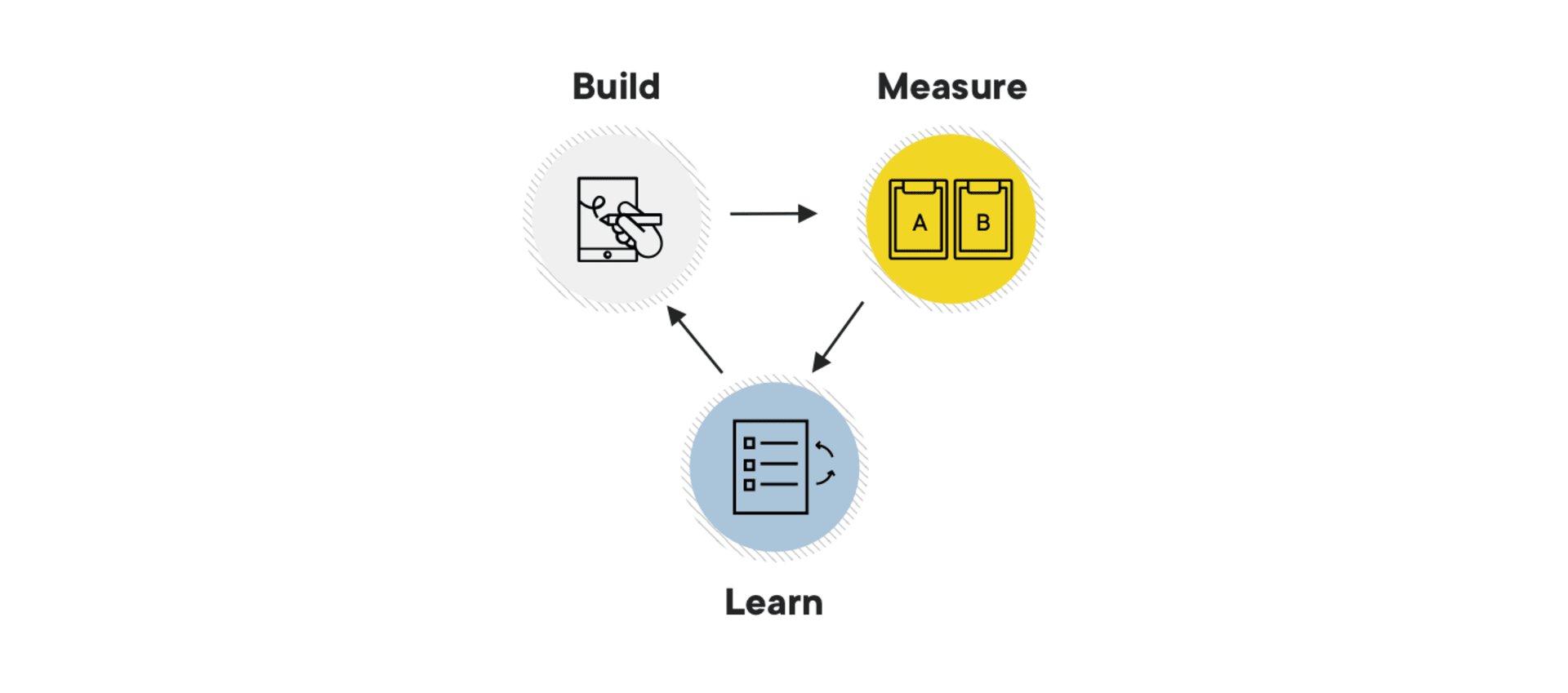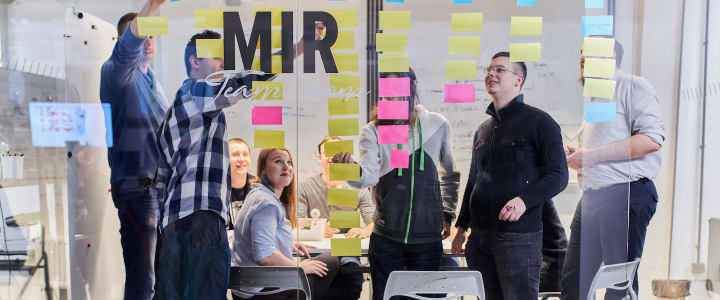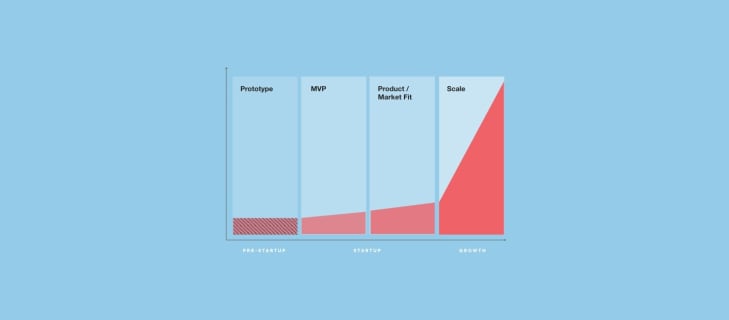Lean Startup Series: Traveling the Build-Measure-Learn Cycle
When you have a big idea in mind, it’s exciting to start building the “brand new, world-changing” product, convinced that everyone will see it like you do. But will they? The lean startup approach, and the build-measure-learn cycle specifically, is a way of learning about user needs, exploring the issues, and testing your idea with the very people you hope will benefit from it. This article explains the basic elements of the build-measure-learn cycle and how you can use it to guide your digital product development to success.

Table of contents
Ever since his 2008 book, “The Lean Startup”, Eric Ries’ lean startup methodology has been one of the most popular approaches to creating digital products. Instead of a ‘have a good idea, build it, then market it’ approach to software development, lean startup puts the product’s end user front and center, insisting that ideas, designs and developments be tested with users as early as possible. This usually involves the use of minimum viable products (MVPs) as a way of getting individual design elements in front of users asap so that feedback can be collected, analyzed and used to inform the next stage of development. Rinse & repeat. Which brings us to one of the core components of the lean startup approach: the build-measure-learn cycle.
What is the Build-Measure-Learn Cycle?
From the start, Ries placed five key principles at the heart of the lean startup methodology:
- Entrepreneurs are everywhere – As in the entrepreneurial goal of aiming to create something new and put it into the hands of those who will find it useful.
- Entrepreneurship is management – There is no one-size-fits-all approach, how you manage your entrepreneurship depends on priorities, circumstances, feedback, etc. (work with what is and not with what you would like or hope to see).
- Validated learning – Test your ideas and developments with representatives of your target audience.
- Innovation accounting – Opinions and feelings are difficult to measure; lean startup uses metrics to track progress and innovation, with an emphasis on customer focus, checking the inevitable assumptions that are found in any new product idea, and Net Present Value, which addresses the product’s financial worth and/or impact.
And, finally
- The Build-Measure-Learn cycle which is woven throughout the lean startup methodology…
In a nutshell, it begins with an idea for a product. This idea is your hypothesis (namely that the product idea will solve a problem for, or otherwise appeal to a target audience. Youbuild something (usually a minimum viable product or some other partial form of product to realize a part of your idea (usually this means a single product feature). The MVP is tested with your target users and their reactions and other feedback are measured and collated. The resulting data is analyzed resulting in new insights and learning about your product idea. As a result, the idea is either confirmed or changed, with any necessary adjustments to your hypothesis. Then it’s back to the beginning of the loop: either the modified idea is built and tested, or it’s on to the next idea/feature…
Why is the Build-Measure-Learn cycle important?
The outcome of using the build-measure-learn cycle is a method of product development that is constantly learning about the needs that the product aims to meet; that constant learning is fed into the design and development process, to the continual and incremental improvement of the product.
However, as well as being a defined systematic process, the build-measure-learn cycle – and really, the whole of the lean startup methodology – is as much a philosophy or an attitude. One that positions user needs and circumstances center-stage, guiding every stage of the product’s development.
In fact, while other methodologies seek to answer the question, How do I build this product?, applying the build-measure-learn cycle provides an answer to, Should I build this product? and If not, what should I build instead?
Benefits – Why do we use Build-Measure-Learn at Boldare?
After 16 years of digital product development, and 300+ successful products, the reasons we’re firmly in favor of build-measure-learn at Boldare are:
- We understand our end users better…
- …And our clients’ business needs too.
- Our focus is always on the ultimate goal of creating a successful product…
- …While the process of product creation is also faster.
- The process of constantly learning and regular fine-tuning of the design means we are very, very agile in how we work.
- The cycle of testing with actual users means that each build-measure-learn cycle builds awareness of the product you’re developing (pre-launch marketing!)
- We don’t waste time pursuing development avenues that won’t work or aren’t wanted…
- …Therefore we make more effective and efficient use of our resources, especially including time.
- The core lean philosophy (data gathering, verifying, learning, changing and pivoting) is also a sound basic business philosophy that meets market needs while minimizing risk.
- Bottom line: we build better products.
Ultimately, the lean startup approach is a framework that has been proven to work – both in its global use, and in our ‘local’ use within Boldare.
Want more?
Consider that every development of a new digital product is an exploration of the unknown. It’s a new idea or a new way of executing an idea and you have no benchmark, no past data to guide you. The build-measure-learn cycle allows you to address that ‘unknown’ piece by piece, in manageable bites. With clear goals, specific hypotheses, targeted testing and analyzed feedback, lean startup brings certainty and clarity to the unknown.
It’s rational. An approach that takes a good idea, builds a full product, then looks to market that product is the digital development version of betting everything on red (or black, if you prefer). Applying build-measure-learn means that instead of gambling your stake (your time and resources), you invest it carefully, piece by piece, determining which angles shouldn’t be pursued, and which are a ‘good bet’.
A typical Build-Measure-Learn process
Hopefully, by now it’s clear that build-measure-learn is a carefully considered, thought-through process. So, although “build” may come first in the name, we don’t start there; after all, before you can build, you need to be clear on what you’re building. In the beginning, is the idea…
- Plan – What’s the idea? What’s the hypothesis? What problem is it you’re aiming to solve with the product? Is it connected to a potential product feature? Or a reaction from potential user/customers? Maybe it’s about pricing or distribution? Obviously, there are a number of aspects to any product which could be ‘built’ and tested. Choose one, and then decide on the data you need to collect and metrics to apply to do so.
- Build – With goals firmly in mind, it’s time to build a minimum viable product, the smallest and simplest possible version that still allows you to test your hypothesis. The MVP is then trialed and tested with your chosen user group.
- Measure – Gather the data to test your hypothesis, using the metrics you’ve identified. What does the data you’ve gathered tell you? How does that compare with the situation in your hypothesis? Is the product idea viable? What changes (if any) need to be made? At a basic level, is there enough interest in the proposed product to continue developing it?
- Learn – Now, it’s time to decide what next? Based on the data you’ve gathered and measured. \ \ If your hypothesis was correct, persevere with the process and apply the build-measure-learn cycle to the next product feature, the next hypothesis. \ \ If your hypothesis was incorrect or requires correction, you pivot. Even now (perhaps especially in this second scenario) you have gathered valuable information and evidence – you know what doesn’t work. Rethink your hypothesis and/or product. Decide what changes are indicated. Formulate a new or amended hypothesis, and then Build again – the cycle continues.
It’s also possible you decide to stop development. Maybe your hypothesis was disproven to such an extent the core idea of the product is in question. Maybe you really are barking up the wrong tree with this one. Even in this eventuality, the build-measure-learn cycle has been a good investment of your time – thanks to this round of partial development and testing, you can decide to invest no more. And with no regrets because thanks to build-measure-learn, you know that the idea has no future and you have the measurements and data to prove it. It’s always better to spend your time and effort on exploring a potential success.
Build-Measure-Learn: a summary
The build-measure-learn cycle is fundamental to a lean startup approach to digital product development. Starting with a research into the proposed user group and the problem the product aims to solve, build-measure-learn ensures a practical focus on user needs. The development of MVPs means you gain maximum information and guidance for the project in return for a minimum investment of time and resources. The design of the product ‘piece-by-piece’ in a series of iterations means the process is agile, easily adjusted or redirected, and the project as a whole is regularly course-corrected for the best possible fit with user needs and wants. Ultimately, the product is more likely to be a success because you’re not flying blind during the development process – the opposite, in fact.

Share this article:









